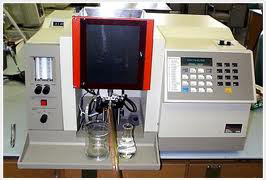AAS - Atomic Absorption Spectroscopy
A Complete Elemental Analysis System
Atomic Absorption Spectroscopy, (
Though the theoretical principles were outlined in the late 19th century by Bunsen and Kirchoff, it was not until the 1950’s that Alan Walsh of the CSIRO developed a working instrument for what is now a well established and widely used technique for this purpose.


Alan Walsh CSIRO 1952
The technology incorporates the ability of metal atoms subjected to thermal energy forcing electrons to transit from a ground state to an excited state by absorbing energy from a light source at a resonant wavelength selective to the element in question, resulting in Atomic Absorption.
AAS basic components:
Optics and Electronics; Comprises, optical components, monochromator, photomultiplier detector, preamplifier, associated electronics, pneumatics (gas box), bench mounted housing, with operator managed stand alone or software driven systems.

The nebulizer; introduces the liquid sample, (at a predetermined flow), into a mixing chamber with gases. The resultant aerosol flows through a flame ignited at the burner head.
Burner Head; 100 or 30 mm slit length. Acetylene – Air flame: (temperatures about 2400 C), for elements of low thermal atomization energy, e.g. Au, Ca, Cu, Fe etc. Acetylene – Nitrous Oxide flame: (temperatures about 2700 C), for elements requiring a higher thermal atomization energy, e.g. Si, Ti, V, W etc.
Hollow cathode Lamp (HCL); comprises a gas filled tube with low pressure argon or neon, a cathode containing the metal of interest and the anode. An applied high voltage ionizes the fill gas which sputters the cathode element resulting in a glow discharge radiation wavelength of narrow line emission specific to the target element. (Multi lamps are available, e.g. Na / K etc). The optical configuration is optimally aligned so that the light radiation is directed longitudinally through the flame path for maximum sensitivity.


Hollow Cathode Lamps
Special considerations:
Background correction; required where molecular absorption overlaps with atomic absorption resulting in spurious high results. A deuterium lamp source placed in a dual lamp system is optically aligned with the HCL source across the flame path. This technique is only applicable at wavelengths < 320 nm. The UV radiation absorbs non elemental radiation and the difference between the two electronically processed, giving a net atomic absorption value.
Ionization interference; ionic species caused by high flame energy depletes the number of ground state atoms reducing sensitivity. This effect is eliminated by adding an excess of ionic compounds of low ionization potential e.g. K, Na, Rb salts, to sample and standards.
Other listed interferences; chemical, matrix, spectral, with special techniques designed to eliminate or reduce their specific effects.
Sensitivity; Flame
Quantitation; Beers Law is applicable but deviates at high sample concentrations. This is rectified by diluting standards and samples to fall into the linear range 0.25 to 0.3 AU for most elements. Microprocessor and software driven instruments apply linearization algorithms as an auto function mode. A standard curve is applied preceded by a blank to zero the instrument with software designed to calculate direct concentration values.


Atomic Absorption Spectrophotometer instrumentation: Perkin Elmer 3100
Associated Techniques:
Graphite Furnace AA, (GFAA); utilizing a graphite tube placed in an electrothermal assembly. Atomization occurs at high temperatures, preceded by drying, pyrolysis, and then a cleaning stage, controlled by a pre-determined temperature ramping sequence. Sensitivities are generally 2 to 3 orders of magnitude to that of flame
Hydride Atomization; useful for determination of As, Sb, Sn, Se, Bi, Pb in the gas phase with the use of a 1% aqueous NaBH producing a volatile metal hydride swept into the atomization chamber and measured by absorption spectrometry. Sensitivity reported to be 10 to 100 times that of alternative methods.
Cold Vapour Atomization; Limited to the determination of Hg by virtue of its high vapour pressure at ambient temperature. Hg is liberated by reducing its ionic form with stannous chloride. The gaseous phase is swept into a cell with Hg absorption at 253.7 nm. Sensitivity is in the ppb range. Used for measuring organic Hg compounds.
Atomic Emission, Atomic Fluorescence Techniques; Less common, but reported to have some benefits over Atomic Absorption.
Related Techniques; Inductively Coupled Plasma – Mass Spectrometry, (ICP-MS), ultra trace element analysis with rapid sample through put. Inductively Coupled Plasma – Optical Emission Spectroscopy, (ICP-OES), a major technique for sequential elemental analysis in aqueous sample matrices.
Further Information & Support:
Techtrader Pty Ltd is well known for its wide range of quality laboratory products, services and solutions for applications in Life Science, Analytical Chemistry and Pharmaceutical Research.
Having supported its customers for over 20 years, Techtrader has developed the expertise to help you decide which apparatus is best suited to your needs.


At Techtrader we have experience with a diverse range of Atomic Absorption Spectrophotometers, brands and related techniques, and can offer Varian, Perkin Elmer,
We stock virtually the entire elemental range of Hollow Cathode Lamps, including multi element lamp configurations. Please contact us with any questions you may have regarding instrumentation, lamps, literature, background information, for solutions to any of your queries.
Take a look and hopefully Techtrader can be of service to you.
http://www.techtrader.com.au/index.html

0 Posted Comments
(1 awaiting approval)Post a Comment